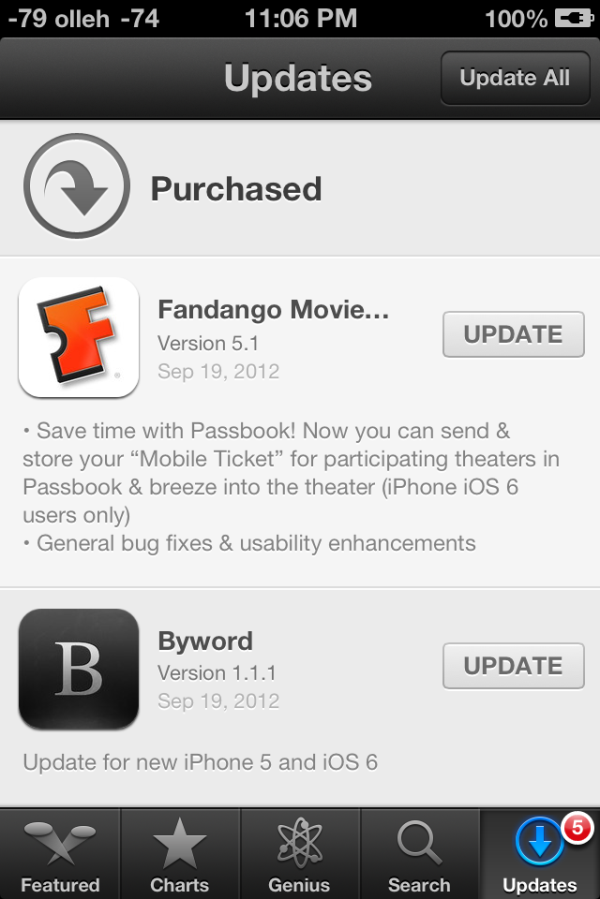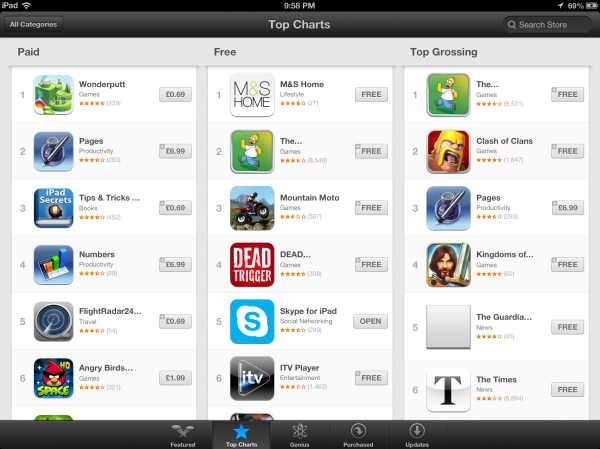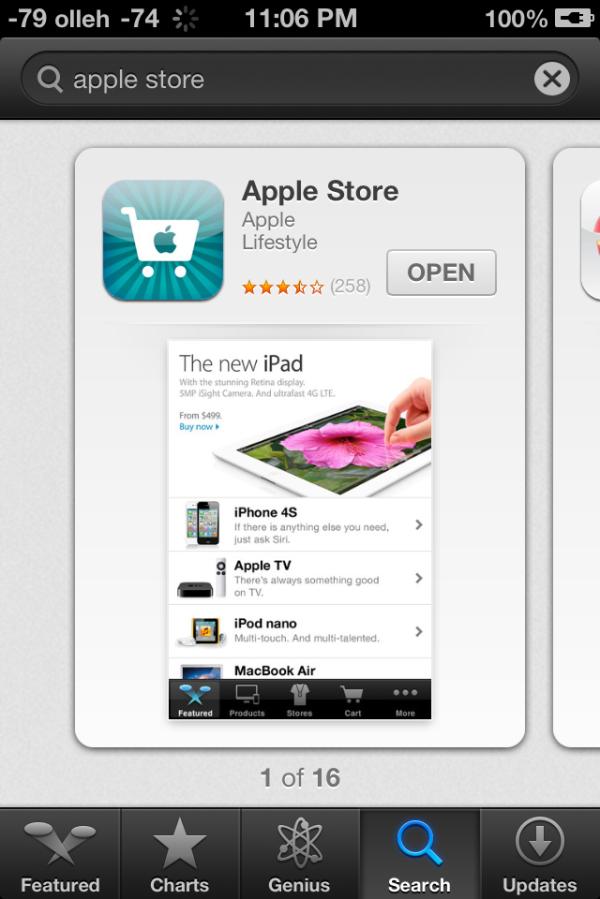The iOS 6 Review: Maps Thoroughly Investigated and More
by Brian Klug & Saumitra Bhagwat on September 19, 2012 2:21 PM ESTApp Store UI Changes
Apple hasn’t made a huge deal about it, but in iOS 6 the App Store UI changes in a dramatic way. The new interface appears to offer greater flexibility for Apple to customize the layout on the fly and change the order of menu items or other features. In addition there are a host of subtle but welcome changes.
The individual app listing page is different, adopting a three-tab system for details about the app, reviews, and a related column with apps by the same developer. There’s a lot more whitespace in the new layout as a whole, and although the changes make the app description pages more inviting I can’t help but shake a suspicion that information density took a hit as a result.
App discovery traditionally has been a challenge for mobile platforms, partly because it’s hard to come up with a good visualization for lots and lots of apps and partly because of the limited display area inherent in a mobile device. Unsurprisingly it seems as though the App Store redesign tries to tackle that problem head-on. First, the bottom bar places Genius dead center and offers a horizontally paginated nearly infinite scrolling list of recommended apps. This basic view also gets copied on the search page – there are pages of apps matching the search term with a big screenshot and install button. Featured gets changed dramatically and Top becomes Charts.

Updates with individual changelogs (Left), New search view (Right)
There are a few friction points which have also been smoothed over. A hugely welcome change is that app updates can now take place without requiring an Apple ID password. Likewise, free applications can be installed from the store without entering a password. Only purchases require a sign-on. The update screen also now has an expandable region under each app for viewing many changelogs at a glance as well. There’s update progress displayed in this menu in addition to on springboard. Newly installed applications also now get a new badge on them which goes away after a first launch.












105 Comments
View All Comments
melgross - Wednesday, September 19, 2012 - link
That's not actually true. The only thing you're limited to buying from Apple is apps. Everything else can be bought elsewhere and read, or played. That's true for books, music, video of any kind, including Tv shows and movies, PDF's, etc.reuthermonkey1 - Thursday, September 20, 2012 - link
Assuming that Apple continues to allow those 3rd party apps to exist in their App Store...GSRennie - Wednesday, September 19, 2012 - link
I would rather buy Apps from the Apple Store and have some confidence that the products have been reviewed for functionality and are virus-free. I gave up on Windows years ago after adding up the time I was spending on malware control using the mix of products that you seemed to need to do a complete job. Add to that the item and money spent to get rid of viruses on various family computers (the kids weren't as cautious as I was). No doubt the Windows world is much more secure these days but I'm not going back. I run the occasional Windows program on Parallels on a laptop (with virus protection). Other than Apps for iPhones, iPads, iPods (all Apple devices), I don't see what outside content I'm blocked from getting by Apple. I can buy any software I can run on OSX and run any Windows software using Boot Camp and a Windows installation or Windows emulation options. As to the agency pricing model Apple and its partner publishers were pushing for textbooks, lets wait for a court ruling on whether that amounts to collusive price fixing. Apple wasn't setting the prices, and the publishers (with some considerable support from authors) were making the case they needed more revenue than derived from Amazon discounted sales to survive. I'm not trying to take sides on that issue until I hear more on the merits of both positions.Sufo - Thursday, September 20, 2012 - link
lol, instead of teaching your kids how to not bork a computer you simply ran away from the problem. If you can afford a mac, you could have afforded to buy them their own shitty laptop, which they could infect to the point of failure and then learn how to deal with the mess themselves... or not. Seems the typical mac user is a lazy parent as well as user!robinthakur - Thursday, September 20, 2012 - link
I think we are coming to the point where a computer should not be easily bork-able because it is essentially just an appliance which is reliable and easy to operate. This means things like OS drives and system files should be hidden to end users, but this would drive us technical types round the bend.The solution to most infections is simply to reinstall and restore/repoint data, and buying them a shitty laptop which may get infected constantly will simply waste time that they could otherqwise spend doing something more useful. Unless you teach your kids how to reinstall Windows also, that's a lot of wasted hours.
Also quite a bit of how you don't get infected is not necessarily teachable, which I realised recently trying to explain it to someone les technical. I was downloading a link from Zdnet and on the page there were loads of ads and download managers that looked like the download button but when you clicked them they tried to install some stupid software. The actual download link was fairly hidden. This and the dangers of pop ups/cookies/add-ins is not an easy subject to teach, its something we have learnewd and now take for granted.
If my Windows 7 or 8 pc (self-built I might add) kept getting infected with malware in a way which was difficult to defend against using the standard approaches, I would 100% look at moving to another infrastructure. Not everybody has the knowledge or time to deal with the problem as we would. It does not denote laziness, simply different priorities than you own. If a curated app store does get around the danger of malware from unsafe install locations, it's not surprising that its incredibly popular with regular users and is now being adapted by most of the companies out there. Even Android only trusts known safe download locations by default.
steven75 - Tuesday, September 25, 2012 - link
Ah the classic "blame the user" mindset instead of the fact that Microsoft Windows is a perilous platform to use when it comes to security.MykeM - Thursday, September 20, 2012 - link
The choice to shop where goods are sold cheaply is all good but it's not without downfall. But as someone pointed out your fury is bit misguided. With the exception of Apps, I can load onto my iPhone movies, books and songs that I got elsewhere. iTunes doesn't differentiate from items bought from its store or downloaded off Google Play- as long the format is compatible.The irony to finding cheaper price elsewhere is that media whether it's from Google Play, Amazon or iTunes, are priced equally. So there's hardly any truth in that argument.
crankerchick - Thursday, September 20, 2012 - link
Your last statement hasn't quite been my experience, at least on the content I purchase. I do don't do a lot of video purchases, but the few I have purchased have generally been cheaper on Amazon. I also routinely find music to be cheaper on Amazon, along with more specials to be had.Also, Apple may allow you to install media purchased from other sources, but it sure doesn't make such options a desired thing to do. Unsupported media formats require third party apps (for a price) along with the archaic way of transferring that content one-by-one, app by by, using iTunes, instead of allowing a true sync, as with supported content.
It is infinitely easier on Android to put the content you want on your device and consume it as you desire.
Again, not nitpicking, as your statements are accurate, but just point out that while Apple may "allow" something, they certainly don't make those "allowed" things something appealing to do.
Petri - Tuesday, September 25, 2012 - link
I have a mac and an iphone and regularly buy content from Amazon - you're right, it is generally cheaper than itunes. It's also very easy to do, since Amazon supply a downloader for the mac which neatly places all your downloaded content directly in iTunes for you.Of course once the content's in itunes, it syncs with the iphone as easily as anything else does.
Stas - Sunday, September 23, 2012 - link
What a can of worms that is. People are surprisingly easily manipulated. The pen is built around them, and they don't notice or care. Thus the the term - iSheep. But it's our nature, I suppose; not inherent to just iFans. Look at our country and "our" government...